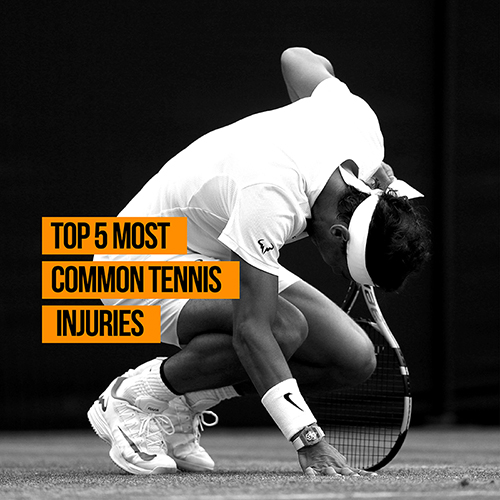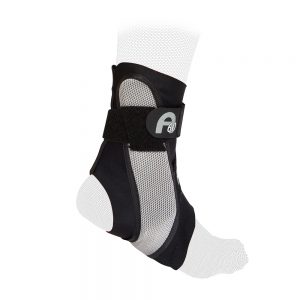Tennis is one of the most demanding sports that you can play, with multiple muscles and joints within your body potentially being pushed to the limits for in some cases, hours on end.
Andy Murray is a prime example of the effects that tennis can have on your body. The Scotsman’s injuries have plagued him throughout his career, and so much so that the former world number one dropped to a world ranking of 839 in summer 2018.
So, in this blog post the experts at PhysioRoom remind at the most common tennis related injuries and how we can help you in preventing them!
The top 5 tennis injuries
Within our top 5 common tennis injuries is a variety of different conditions that affect numerous parts of the body. It is important to know the common injuries that you are at risk of whilst playing tennis, so you can put preparations in place to help you mitigate the chances of falling victim to these mishaps in the future.
So, lets get right into it!
Sprained Ankle
Sprained ankles are relatively common in tennis players, as the likes of Roger Federer and Andy Murray have all suffered this injury. Sprained ankles tend to occur on the court when players sharply twist or turn, and subsequently strain or tear the ligaments that connect their leg and feet bones.
If you suffer a sprained ankle, it is important to carry out the PRICE procedure (Protection, Rest, Ice, Compression, Elevation) as soon as possible. In addition to his, when you’re ready it can also help to have rehabilitation sessions with a chartered physiotherapist to help build up the strength of your injured ankle ligaments.
In terms of preventing a re-occurrence of your ankle injury, wearing a suitable ankle brace can be massively effective. One ankle support that is popular among our customers as well as the professionals themselves is the superb Aircast A60 Ankle Brace.
Shoulder Pain
Shoulder pain can occur in tennis players because there are repeated stresses during tennis strokes, particularly the serve. There are several sources of shoulder pain in tennis players, but one of the most common causes is shoulder bursitis. Bursitis is inflammation of a sack of fluid called the bursa which causes pain whenever the arm is raised.
If you’re experiencing shoulder pain whilst playing tennis, completing shoulder stabilisation exercises with a chartered physiotherapist can certainly help you get back on the court sooner rather than later. It is also pivotal to make sure that during your rehabilitation period, you do not overload your shoulder with too much tennis training or competition!
Furthermore, using ice therapy is also key in reducing the inflammation that’s associated with shoulder pain. The most effective way of reducing your shoulder pain through ice therapy is by using the Shoulder Cryo Cuff (below).
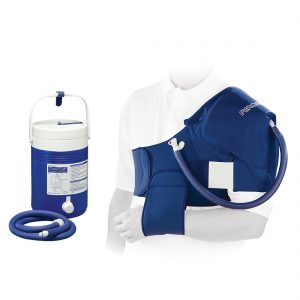
Calf Strain
The calf muscle group consists of the Gastrocnemius, Soleus and Plantaris muscles, situated at the back of the lower leg. Their function is to pull up on the heel bone and these muscles are most active during the push-off when a tennis player must move quickly to react to an opponent’s shot. A strain occurs when the muscle is forcibly stretched beyond its limits and the muscle tissue becomes torn.
To help in reducing the chances of suffering a calf strain whilst on the court, making changes to your diet to ensure that more carbohydrates are consumed in the build-up to your match can be massively beneficial. Also, taking on carbohydrates and fluids on board during your match can also help provide fuel for your calf muscles for the duration of your game.
As ever, the PRICE protocol is pivotal during the immediate treatment of a calf strain to reduce bleeding within the muscle tissue. In addition to this, many tennis players who suffer calf strains use calf supports to provide reassurance and therapeutic heat following a calf muscle injury. One of the most effective calf supports that we supply here at PhysioRoom is the Neo G Calf/Shin Splint Support.
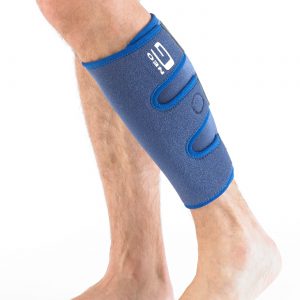
Stress Fracture of the Back
Serving in tennis requires a combination of spinal hyperextension (bending back) together with rotation and side bending of the trunk. This puts a lot of stress on an area of the vertebra called the Pars Interarticularis and this is where the stress fracture develops.
Practising the service should be carefully monitored by your coach to ensure the lower back is not being overloaded. This is particularly important in adolescent players who have just experienced a growth spurt as they are known to be more at risk from this injury.
In most cases, complete rest from tennis is the treatment of choice. This would usually be for a period of 6 weeks to allow the bone to heal. In addition to this, the pain associated with a stress fracture can also be alleviated by using a soothing Heat Pack (below).
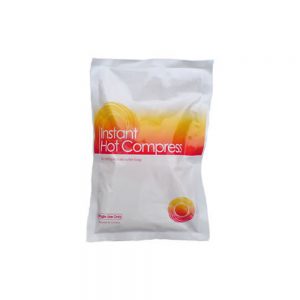
Tennis Elbow
Tennis elbow is inflammation of the muscles and tendons of the forearm as they attach to the humerus (upper arm) bone. This inflammation is caused by prolonged gripping activities which includes, of course, racquet sports. Tennis elbow causes pain when the lateral epicondyle (outermost part of the elbow) is touched and if the elbow is straight and the hand is moved forward and back at the wrist.
Making sure that your tennis racquet is the correct size for your hand can help in preventing tennis elbow, as it will stop you from gripping too hard. Furthermore, if you are playing tennis for the first time in a while, making sure you have regular breaks and working the muscles that stretch over by doing ‘limp wrist’ and ‘policeman halting traffic’ type stretches is crucial.
For those who are looking to treat their tennis elbow, firstly you must control the inflammation by simply resting or by using anti-inflammatory medication. Furthermore, devising an eccentric strengthening programme for the extensor tendon with the help of a chartered physiotherapist can also be vital on your road to recovery. If you have suffered from tennis elbow in the past, you can protect your wrist extensor muscles whilst playing tennis by checking out the Ultimate Performance Tennis Elbow Support (below).
Arm & Elbow Supports that you can rely on
At PhysioRoom, we are proud to provide tennis players with the arm and elbow supports that they need to help them in reaching the top of their game.
So, don’t let injury get in the way of your goals, and check out our vast collection of Arm and Elbow Supports now.


